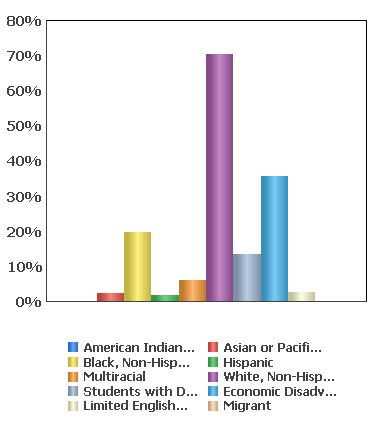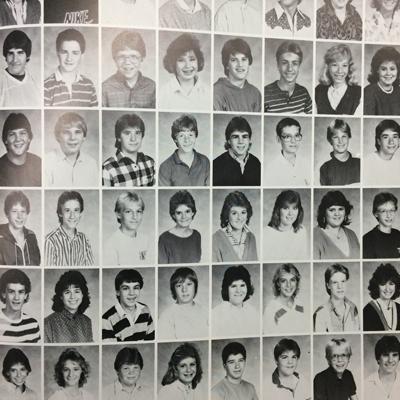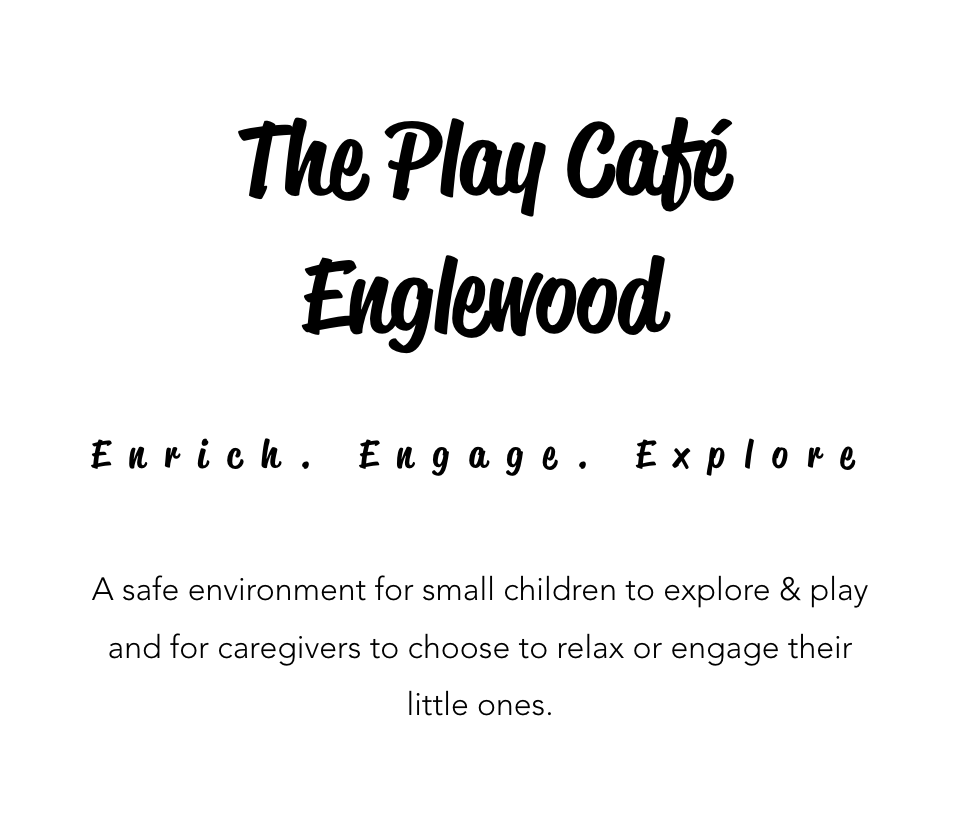Northmont High School Diversity Report
Accommodating Cultures & Facilitating Acceptance

Enrollment to Northmont in 2015. Graph courtesy of Education.Ohio.Gov.
November 12, 2015
When I moved to the suburban Northmont district from inner-city Dayton Public Schools my first grade year, I experienced a jolting case of culture shock. I distinctly remember sitting in the office beside my mother on the first day and watching students in single-file lines, thumbs locked behind their backs, walk back and forth from classrooms. After about thirty minutes of counting students who looked like me on my fingers, with fists still closed and palms now sweaty, I leaned over to my mother and asked, in a whisper, “Do any black people go to this school?”
My mother laughed at me. “Of course,” she promised. My mother explained that I simply hadn’t seen any yet, and that there were plenty who I would soon meet and add to the long list of friends she was sure I’d make.
In the midst of my senior year, I now of course realize how silly I was to doubt the diversity of the Northmont school district. There is a beautiful arrangement of creed and color here, as I see both a multitude of students who look and live like I do and multitude of those who do not.
This is not unusual in terms of statistical growth. As the cultural assortment of America has diversified, so has that of high schools. The Census Bureau predicts that by the year 2100, the U.S. population of non-Hispanic whites will fall to 40%–this number will still significantly trump that of any other ethnicity, but it will be an all-time low percentage of white people. And as America becomes more diverse and less dominated by the white, Anglo-Saxon, and protestant (WASP), schools are diversifying in the same manner.
According to Education.Ohio.gov, the Northmont school district has twice as many minority students in 2015 than just twelve years ago, in 2003. In that year, people of color made up 13.6% of the student body–today that number has gone to 29.7%. However, although the amount of students of color has grown, white students still make up the bulk of the student body, composing 70.2% of Northmont’s population.
Still, all you have to do is flip through a yearbook from the 80s to realize how much the student body has changed in terms of multicultural make-up.

Although Northmont’s diversity looks good–well, better–in terms of statistics, diversity goes beyond numbers. Having a diverse environment does not only mean the student body is made of people from many different backgrounds, but also implies that everyone in attendance is respectful of these backgrounds. Diversity is much more about acceptance than percentages. When discussing the diversity of Northmont, it would be more beneficial to examine how culturally responsive students are in the realm of interethnic relations, religious acceptance, socio-economic interactions, and nationalistic differences.
Over 78% of Northmont students believe diversity is important in educational settings. GreatSchools.org explains that there is a certain “richness” which comes from working with “others who are not of the same cookie-cutter mold.”
“It’s beneficial for students to be exposed to different cultures and ideas, so diverse environments are important,” said senior Chris Chae.
Although students agree that diversity is important and valuable, it is recognized that it is not necessarily prevalent in their everyday lives. When students were asked to consider their own race, nationality, religion, and socio-economic status, they were encouraged to think about these features in the people around them. When taking a close look at the smaller social groups which form within the Northmont halls, it is obvious and apparent that even in diverse environments it is habit to gravitate towards people like you.
“Just because our school is diverse, people don’t go outside of their comfort zone,” said senior Riley Jenkins.
In a survey of 100 randomly selected Northmont students, 75 reported to have a majority, or at least 51%, of friends the same race as them. Approximately 72 of these students reported having a majority of friends within the same socioeconomic status and who practiced the same religion.
This separation within friend groups is better understood when examining them more closely. Surveyed students reported that amongst their five closest friends, there is little to no diversity. About 55% of students have no more than one, if any, friend(s) of a different race than themselves. In regards to religion, 36% of students reported having one or no friends of different religions.
“It’s just human nature. As humans and individuals we’re drawn to people like ourselves,” said sociology and psychology teacher Ms. Erin Snowden. “We seek out those reflective of ourselves and shy away from what’s different.”
On a slightly larger scale, classrooms are generally made of students like one another as well.
Nearly 54% of students reported that the majority of their classmates were of the same race as them.
When asked to think about permanent teachers and coaches of color, 88% of students have had no more than two instructors of color during their entire time within the Northmont school district.
Whereas Northmont statistically seems to model the “melting pot” metaphor for America, realistically it demonstrates how simply putting ingredients in a pot is not always enough to mix them together. Instead of a mixture or blend, Northmont can be more accurately described as a stew. All of the ingredients occupy the same space, and often compliment each other, but they are still easily separated. This separation is noticeable in the cafeteria, in classes in which students choose their own seats, and in the hallways as students gather into groups with people the most like themselves.
Improving diversity beyond statistics is extremely important if high schools are to condition students for the real world. As explained on GreatSchools.org, learning not only alongside but with those unlike ourselves allows students to “develop an understanding of the perspectives of children from different backgrounds and learn to function in a multicultural, multiethnic environment.”
Gaining this functionality is crucial to working comfortably and collaboratively with others, as over 30% of surveyed students reported feeling discomfort in settings in which they are of the minority.
“I have felt uncomfortable being the minority in a group,” said junior Megan McKarns. “Whenever I am in a group of people who do not have the same religion as me, I feel like I’m being judged for my beliefs.”
As students from different groups slowly engage with one another, Northmont works to accommodate diversity. Teachers often have to adjust methods and approaches to tailor their teaching styles to the evermore complicated collection of students on their class roster.
“Teachers have to be fluid with their understanding,” said Snowden, who has watched Northmont diversify in her years as a Northmont student and her twelve years teaching at the school. “The diverse population is hard when teachers are not flexible.”
The same can be said for administrators and the rules or regulations of the district. Northmont is changing, therefore it must develop into a safe and comfortable place for people from all backgrounds. Of course, this is easier said than done. However, even some current rules demonstrate Northmont’s commitment towards this cause, like the rule against shirts with hate speech slogans or the conditional allowance of culturally/religiously significant headscarves. Policies exist to facilitate diversity, but there is still a serious lack of fluidity when these policies must begin to work on the behalf of everyone. Socially, Northmont still deflects from unifying students by avoiding serious, direct conversations about cultural differences; lessons in which these students can be made aware of said differences and ensured that they are okay.
Just as the United States as a whole is still figuring diversity out, Northmont is working on developing into an environment in which students learn and experience together and not just within the same space. Furthermore, and more importantly, it is time for Northmont students to take advantage of the array of people here and open up to learning from each other. The Northmont student body must make an effort to move the district beyond statistical diversity and into a place of acceptance and cultural exchange.













Jakob Glass • Nov 16, 2015 at 10:34 am
Very nice article. I appreciate the insightful points you make, and all the time you put into researching and creating this.
Anonymous • Nov 12, 2015 at 2:09 pm
Goooo Jaylin!